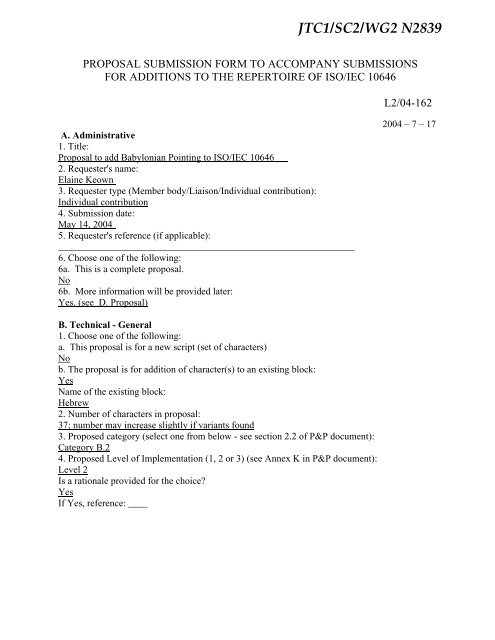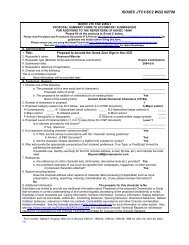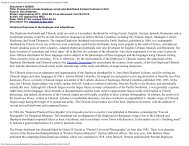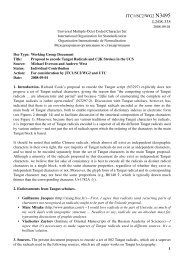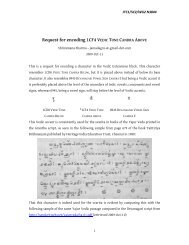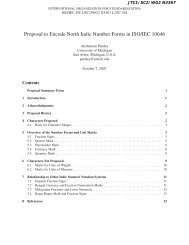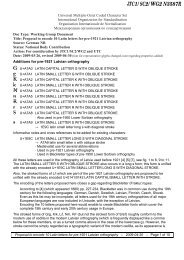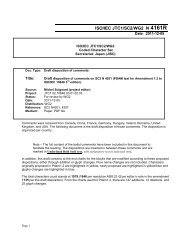JTC1/SC2/WG2 N2839 - DKUUG standardizing
JTC1/SC2/WG2 N2839 - DKUUG standardizing
JTC1/SC2/WG2 N2839 - DKUUG standardizing
You also want an ePaper? Increase the reach of your titles
YUMPU automatically turns print PDFs into web optimized ePapers that Google loves.
PROPOSAL SUBMISSION FORM TO ACCOMPANY SUBMISSIONS<br />
FOR ADDITIONS TO THE REPERTOIRE OF ISO/IEC 10646<br />
A. Administrative<br />
1. Title:<br />
Proposal to add Babylonian Pointing to ISO/IEC 10646<br />
2. Requester's name:<br />
Elaine Keown<br />
3. Requester type (Member body/Liaison/Individual contribution):<br />
Individual contribution<br />
4. Submission date:<br />
May 14, 2004<br />
5. Requester's reference (if applicable):<br />
_____________________________________________________________<br />
6. Choose one of the following:<br />
6a. This is a complete proposal.<br />
No<br />
6b. More information will be provided later:<br />
Yes. (see D. Proposal)<br />
<strong>JTC1</strong>/<strong>SC2</strong>/<strong>WG2</strong> <strong>N2839</strong><br />
B. Technical - General<br />
1. Choose one of the following:<br />
a. This proposal is for a new script (set of characters)<br />
No<br />
b. The proposal is for addition of character(s) to an existing block:<br />
Yes<br />
Name of the existing block:<br />
Hebrew<br />
2. Number of characters in proposal:<br />
37; number may increase slightly if variants found<br />
3. Proposed category (select one from below - see section 2.2 of P&P document):<br />
Category B.2<br />
4. Proposed Level of Implementation (1, 2 or 3) (see Annex K in P&P document):<br />
Level 2<br />
Is a rationale provided for the choice?<br />
Yes<br />
If Yes, reference: ____<br />
L2/04-162<br />
2004 – 7 – 17
Proposal to add Babylonian Pointing to ISO/IEC 10646 2<br />
5. Is a repertoire including character names provided?<br />
Partial repertoire included, waiting on font—names preliminary<br />
a. If YES, are the names in accordance with the “character naming guidelines”<br />
in Annex L of P&P document?<br />
Yes<br />
b. Are the character shapes attached in a legible form suitable for review? A few are.<br />
B. Technical - General<br />
6. Who will provide the appropriate computerized font (ordered preference: True Type, or<br />
PostScript format) for publishing the standard?<br />
John Hudson Tiro Typeworks True Type<br />
If available now, identify source(s) for the font (include address, e-mail, ftp-site, etc.) and indicate<br />
the tools used:<br />
Font should be available sometime in summer or fall 2004<br />
7. References:<br />
a. Are references (to other character sets, dictionaries, descriptive texts etc.) provided?<br />
Yes, see Bibliography.<br />
b. Are published examples of use (such as samples from newspapers, magazines, or other sources)<br />
of proposed characters attached?<br />
No<br />
8. Special encoding issues:<br />
Does the proposal address other aspects of character data processing (if applicable) such as input,<br />
presentation, sorting, searching, indexing, transliteration etc. (if yes please enclose information)?<br />
No<br />
9. Additional Information:<br />
Several characters resemble existing Unicode Hebrew or possibly Syriac diacritics, but they have<br />
different semantic meaning (represent different Hebrew vowels, etc.)<br />
C. Technical - Justification<br />
1. Has this proposal for addition of character(s) been submitted before?<br />
No<br />
2. Has contact been made to members of the user community (for example: National Body,<br />
user groups of the script or characters, other experts, etc.)?<br />
Yes. Proposer will be contacting Aramaists and other potential users. She has already been in<br />
contact with two largest computational Aramaic projects, the CAL (Comprehensive Aramaic<br />
Lexicon, Cincinnati), and a new targum project in Kampen (The Netherlands).<br />
3. Information on the user community for the proposed characters (for example:<br />
size, demographics, information technology use, or publishing use) is included?<br />
The user community includes computational Aramaists and Hebraists worldwide. The targums,<br />
the Aramaic translations of the Bible, are among the earliest and most important translations.<br />
Many of them use Babylonian pointing. Some targum texts may be available exclusively in this<br />
pointing system. Others are preserved in both Tiberian and Babylonian pointing. In addition,<br />
Babylonian pointing was used in Yemen for all pointed writing until the late 1780s. The<br />
Yemenite manuscript tradition is among the most important.
Proposal to add Babylonian Pointing to ISO/IEC 10646 3<br />
Reference: ___________________________<br />
4. The context of use for the proposed characters (type of use; common or rare)<br />
Widely used by scholars.<br />
Reference: _____________________________________________________________________<br />
C. Technical - Justification<br />
5. Are the proposed characters in current use by the user community?<br />
Yes<br />
If YES, where? Reference:<br />
______________________________________________________________<br />
6. After giving due considerations to the principles in the P&P document must the proposed<br />
characters be entirely in the BMP?<br />
That would be more desirable. This is the second-most important pointing system.<br />
If YES, is a rationale provided?<br />
Yes, see 3._____________<br />
If YES, reference: ________________________________________________________<br />
7. Should the proposed characters be kept together in a contiguous range (rather than being<br />
scattered)?<br />
Yes<br />
8. Can any of the proposed characters be considered a presentation form of an existing<br />
character or character sequence?<br />
No<br />
If YES, is a rationale for its inclusion provided?<br />
If YES, reference: ________________________________________________________<br />
9. Can any of the proposed characters be encoded using a composed character sequence of either<br />
existing characters or other proposed characters?<br />
Yes<br />
If YES, is a rationale for its inclusion provided?<br />
Yes, see proposal.<br />
If YES, reference: ______________<br />
10. Can any of the proposed character(s) be considered to be similar (in appearance or function)<br />
to an existing character?<br />
Yes<br />
If YES, is a rationale for its inclusion provided?<br />
Yes, see D. Proposal.<br />
If YES, reference: ________________________________________________________<br />
11. Does the proposal include use of combining characters and/or use of composite<br />
Yes<br />
If YES, is a rationale for such use provided?<br />
Yes, see B.9____________ If YES, reference:<br />
_______________________________________________________<br />
Is a list of composite sequences and their corresponding glyph images (graphic symbols)<br />
provided?<br />
Yes<br />
If YES, reference: _______________________________________________________
Proposal to add Babylonian Pointing to ISO/IEC 10646 4<br />
12. Does the proposal contain characters with any special properties such as<br />
control function or similar semantics?<br />
No<br />
If YES, describe in detail (include attachment if necessary) ______________<br />
13. Does the proposal contain any Ideographic compatibility character(s)?<br />
No<br />
D. Proposal<br />
The Hebrew and Aramaic languages have been written with 6 sets of diacritics for vowels and 4<br />
sets for punctuation, accents, and text markup:<br />
1. Tiberian - the vowels, accents, and diacritics (incompletely) in Unicode<br />
2., 3., 4. Simple Babylonian 1 and 2, Complex Babylonian – this proposal<br />
5. Samaritan – see proposal at http://www.lashonkodesh.org/samarpro.pdf<br />
6. Palestinian – another regional system of diacritics, not as widely known<br />
In addition, the Hebrew language has been written in at least two sets of ‘base characters,’ namely<br />
Hebrew and Arabic.<br />
The Aramaic language, apparently the most polyscriptal on earth, has been written in at least eight<br />
writing systems, including both Hebrew (= ‘Aramaic square script’ and its glyphic variants) and<br />
Arabic characters, plus Syriac, Roman, Cyrillic, and all the Egyptian writing systems except for<br />
the most recent (Coptic).<br />
Simple Babylonian 1 and 2<br />
The two Simple Babylonian vowel systems overlap some. The noted scholar Aron Dotan writes :<br />
"There are two sets of signs in Babylonian vocalization :<br />
(a) the regular Babylonian set, which consists (in part) of lines,<br />
whose origin is in letters, and (in part) of dots; (b) a set which<br />
consists entirely of dots and is relatively rare."<br />
Dotan goes on to completely describe both sets of Simple Babylonian, including the points which<br />
are found in both Simple Babylonian systems.<br />
NOTE : graphics for the character repertoire are not shown, since the font is not done.
Proposal to add Babylonian Pointing to ISO/IEC 10646 5<br />
Babylonian cantillation marks<br />
0826 HEBREW BABYLONIAN ACCENT ETNACHTA<br />
0827 HEBREW BABYLONIAN ACCENT ZAQEF<br />
0828 HEBREW BABYLONIAN ACCENT TEVIR<br />
0829 HEBREW BABYLONIAN ACCENT MINOR DISJUNCTIVE1<br />
082A HEBREW BABYLONIAN ACCENT MINOR DISJUNCTIVE2<br />
082B HEBREW BABYLONIAN ACCENT DEHI<br />
082C HEBREW BABYLONIAN ACCENT ALTERNATE DEHI<br />
082D HEBREW BABYLONIAN ACCENT HAZER<br />
082E HEBREW BABYLONIAN ACCENT TERES<br />
082F HEBREW BABYLONIAN ACCENT NEGDA<br />
= legarmeh<br />
0830 HEBREW BABYLONIAN ACCENT ZARQA<br />
0831 HEBREW BABYLONIAN ACCENT SEGOL<br />
0832 HEBREW BABYLONIAN ACCENT ALTERNATE ZARQA<br />
0833 HEBREW BABYLONIAN ACCENT ALTERNATE TERES<br />
0834 HEBREW BABYLONIAN ACCENT YETIV<br />
0835 <br />
0836 <br />
0837 <br />
Simple Babylonian points<br />
0838 HEBREW SIMPLE BABYLONIAN POINT KHETFA<br />
= Tiberian SHEVA<br />
0839 HEBREW SIMPLE BABYLONIAN POINT HIRIQ<br />
0840 HEBREW SIMPLE BABYLONIAN POINT TSERE OR SEGOL<br />
0841 HEBREW SIMPLE BABYLONIAN POINT MIFTAKH PUMA<br />
OR PITKHA (two glyphs)<br />
0842 HEBREW SIMPLE BABYLONIAN POINT ALTERNATE<br />
MIFTAKH PUMA OR PITKHA<br />
0843 HEBREW SIMPLE BABYLONIAN POINT MIKPATZ PUMA OR<br />
MITSAF PUMA<br />
= Tiberian QAMATS
Proposal to add Babylonian Pointing to ISO/IEC 10646 6<br />
0844 HEBREW SIMPLE BABYLONIAN POINT ALTERNATE<br />
MIKPATZ PUMA OR MITSAF PUMA<br />
= Tiberian QAMATS<br />
0845 HEBREW SIMPLE BABYLONIAN POINT SECOND ALTERNATE<br />
MIKPATZ PUMA OR MITSAF PUMA<br />
= Tiberian QAMATS<br />
0846 HEBREW SIMPLE BABYLONIAN POINT HOLAM<br />
0847 HEBREW SIMPLE BABYLONIAN POINT QUBUTS<br />
0848 HEBREW SIMPLE BABYLONIAN POINT ALTERNATE QUBUTS<br />
0849 <br />
084A <br />
Complex Babylonian points<br />
084B HEBREW COMPLEX BABYLONIAN POINT ??<br />
084C HEBREW COMPLEX BABYLONIAN POINT ??<br />
084D HEBREW COMPLEX BABYLONIAN POINT ??<br />
084E HEBREW COMPLEX BABYLONIAN POINT ??<br />
084F HEBREW COMPLEX BABYLONIAN POINT ??<br />
0850 HEBREW COMPLEX BABYLONIAN POINT ??
Proposal to add Babylonian Pointing to ISO/IEC 10646 7<br />
0851 HEBREW BABYLONIAN ALTERNATIVE RAFE<br />
0852 HEBREW BABYLONIAN PUNCTUATION SOF PASUQ<br />
0853 HEBREW BABYLONIAN PUNCTUATION ALTERNATE<br />
SOF PASUQ<br />
0854 HEBREW BABYLONIAN PUNCTUATION RESHIT PASUQ<br />
0855 HEBREW BABYLONIAN PUNCTUATION ALTERNATE<br />
RESHIT PASUQ<br />
0856 HEBREW BABYLONIAN PUNCTUATION VERSE SEPARATOR<br />
Extra letters for Babylonian sin and shin<br />
0857 HEBREW BABYLONIAN LETTER SIN<br />
0858 HEBREW BABYLONIAN LETTER SHIN<br />
Unicode Character Properties<br />
08 ;HEBREW SIMPLE BABYLONIAN POINT HIRIQ;Mn; ?<br />
08 ;HEBREW SIMPLE BABYLONIAN POINT TSERE;Mn; ?<br />
08 ;HEBREW SIMPLE BABYLONIAN POINT MIFTACH PUMA;Mn; ?<br />
08 ;HEBREW SIMPLE BABYLONIAN POINT ---;Mn;<br />
08 ;HEBREW SIMPLE BABYLONIAN POINT ---;Mn;<br />
08 ;HEBREW SIMPLE BABYLONIAN POINT ---;Mn;<br />
08 ;HEBREW SIMPLE BABYLONIAN POINT ---;Mn;<br />
08 ;HEBREW SIMPLE BABYLONIAN POINT ---;Mn;<br />
08 ;HEBREW SIMPLE BABYLONIAN POINT ---;Mn;<br />
08 ;HEBREW COMPLEX BABYLONIAN POINT ---;Mn;<br />
08 ;HEBREW COMPLEX BABYLONIAN POINT ---;Mn;<br />
08 ;HEBREW COMPLEX BABYLONIAN POINT ---;Mn;<br />
08 ;HEBREW COMPLEX BABYLONIAN POINT ---;Mn;<br />
08 ;HEBREW COMPLEX BABYLONIAN POINT ---;Mn;<br />
08 ;HEBREW COMPLEX BABYLONIAN POINT ---;Mn;<br />
08 ;HEBREW BABYLONIAN LETTER SIN;<br />
08 ;HEBREW BABYLONIAN LETTER SHIN;<br />
MANUSCRIPT SCANS :<br />
Or. 2363<br />
Qafih (Daniel)
Proposal to add Babylonian Pointing to ISO/IEC 10646 8<br />
MANUSCRIPTS TO EVENTUALLY CONSULT :<br />
Or. 1467<br />
Or. 2228, 2229, 2230<br />
Or. 2211<br />
Or. 1474<br />
Or. 1473<br />
Or. 2374<br />
Or. 2210<br />
Or. 1472<br />
Or. 1471<br />
Simple Babylonian :<br />
T-S Box A38,5 Cambridge University<br />
INDIVIDUAL SCHOLARS CONSULTED :<br />
Prof. Stephen Kaufman, CAL (Comprehensive Aramaic Lexicon), Hebrew Union College,<br />
Cincinnati.<br />
BIBLIOGRAPHY:<br />
Dotan, Aron. “Masorah.” Encyclopaedia Judaica. Keter: Jerusalem, 1971, cols. 1441-1447.<br />
Keown, E.R. “Hebrew alphabets, symbols and computer codes: history and preliminary<br />
tabulation.” Revue des Études Juives, 161 (1-2), pp. 235-240. N.B. this article is an earlier and<br />
less interesting version of my research and has miscellananeous errors, e.g., I have never had an<br />
affiliation with UPenn; there is one chronological error.<br />
Knudsen, Ebbe E. A Targumic Aramaic Reader : Texts from Onkelos and Jonathan. Leiden :<br />
E. J. Brill, 1981.<br />
Morag, Shelomo. The vocalization systems of Arabic, Hebrew, and Aramaic; their phonetic and<br />
phonemic principles. 's-Gravenhage: Mouton, 1962 [c1961].<br />
Sa’adia ben Joseph and Shelomo Morag. The book of Daniel : a Babylonian-Yemenite<br />
manuscript. Jerusalem : Kiryat-Sepher, c1973.<br />
Tov, E. Textual Criticism of the Hebrew Bible. Fortress Press : Minneapolis, 1992. Plate 14 (p.<br />
394) : ‘simple’ Babylonian ms, T-S Box A38,5.
Proposal to add Babylonian Pointing to ISO/IEC 10646 9<br />
Figures :<br />
Figure 1 : Or. 2363 (printed facsimile, Targum Onkelos, starting Genesis 1 :1); Knudsen, p. 19.<br />
Figure 2 : Qafih Yemenite-Babylonian ms (Book of Daniel), Morag. (Note : manuscript scan<br />
was processed in Adobe Photoshop to widen distance between lines and to leave only the<br />
Aramaic.)


